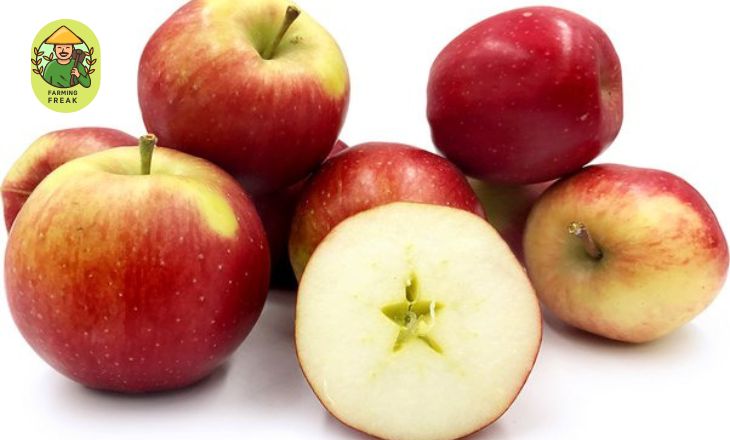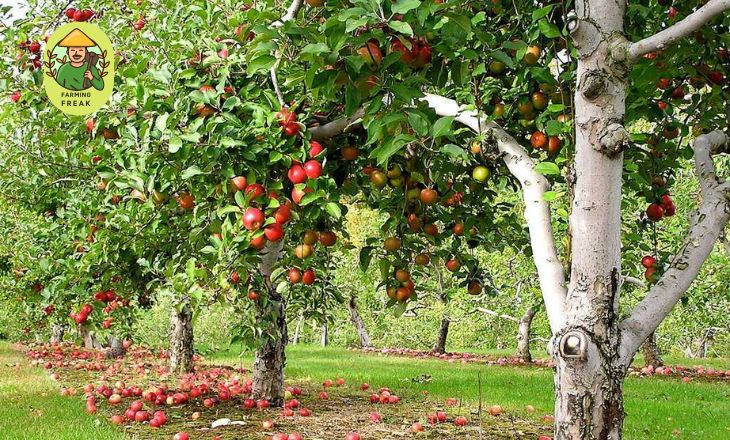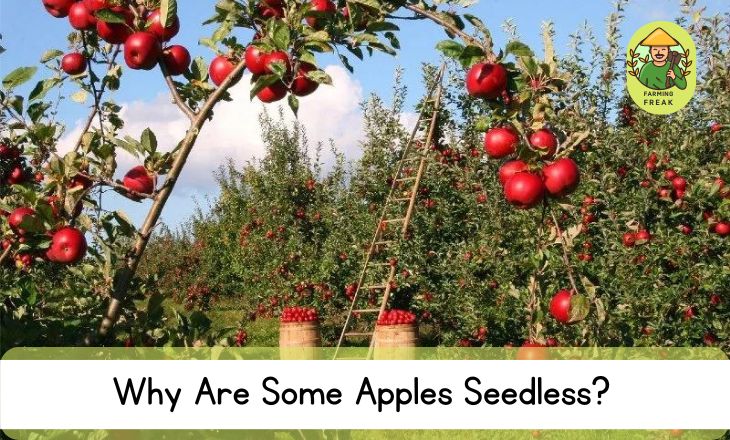When you bite into a crisp, juicy apple only to find it completely seedless. It may seem like a magical anomaly, but the existence of coreless apples is a fascinating scientific marvel. The mystery behind seedless apples unveils a fascinating tale of innovation, nature’s quirks, and human intervention in the world of fruit cultivation.
Do u think Why Are Some Apples Seedless? These apples, lacking the telltale seeds found at the core of their conventional counterparts, raise intriguing questions about nature’s intricate design and the mysteries of genetic modification.
Let’s explore the intriguing realm of coreless apples – those elusive fruits that defy the conventional expectation of crunchy seeds nestled within their juicy flesh. Join us to uncover the secrets behind these unique specimens and unravel the curious case of apples without seeds.
Origins and Development Seedless Apples
The development of seedless apples can be traced back to ancient times when farmers discovered natural mutations in apple trees that produced fruit with fewer or no seeds like edible weeds. Over centuries, selective breeding and cross-pollination techniques were used to cultivate seedless varieties with desirable traits such as sweetness, crispness, and resistance to diseases.
One key milestone in the development of seedless apples was the discovery of a naturally occurring mutant tree in Japan that consistently produced seedless fruit, leading to the creation of popular varieties like Fuji and Gala.
Today, advancements in biotechnology have enabled researchers to develop new techniques for producing seedless apples through genetic modification. By manipulating specific genes responsible for seed formation, scientists can create sterile fruits that still retain the taste and appearance of traditional apples.
Why Are Some Apples Seedless?
The answer to this question Why Are Some Apples Seedless is quite simple, Seedless apples, also known as parthenocarpic apples.
These are the result of a genetic mutation that prevents the formation of seeds within the fruit. This mutation disrupts the normal pollination process, leading to fruits that develop without fertilization.

While seedless fruits may seem like a modern convenience, they have been around for centuries and are a product of both natural and artificial selection.
The phenomenon of seedlessness in apples offers a fascinating look into nature’s ability to adapt and evolve in unexpected ways. It opens up interesting debates about the pros and cons of human intervention in plant breeding practices and raises questions about the future sustainability of our food sources like kaffir lime leaves and Huitlacoche in a rapidly changing world.
How Seedless Apples Are Created?
Genetic Modification plays a crucial role in the creation of seedless apples, with researchers working to develop new techniques that eliminate the need for seeds while maintaining the flavor and texture of the fruit.
One approach involves utilizing gene-editing tools to target specific genes responsible for seed development, effectively turning off seed formation in the apple. This revolutionary technique allows scientists to create coreless apples that are not only more convenient for consumers but also help reduce waste in food production.
What Varieties of Apples are Seedless?
While traditionalists may argue that seeds are an integral part of an apple’s natural makeup, the idea of a seedless apple may sound like something out of a science fiction novel, but several varieties exist in reality.
- SweeTango
- Arctic® apple
- Spencer Seedless Apples
- Wellington Bloomless
- Granny Smith Apples
SweeTango
One of the most well-known seedless apples is the SweeTango, a hybrid between the Honeycrisp and Zestar! apples. This variety offers a crisp and juicy texture with a perfect balance of sweetness and acidity.
Arctic® apple
Another popular seedless apple is the Arctic® apple, which has been genetically modified to prevent browning when cut. This innovation has made it more convenient to enjoy sliced apples without worrying about them turning brown before you can finish eating them.
Spencer Seedless Apples
The Spencer Seedless stands out as a popular choice for its sweet flavor and crunchy texture. This variety is perfect for snacking or adding to salads, offering a convenient and enjoyable eating experience.

Wellington Bloomless
Wellington Bloomless apples are another seedless option that boasts a unique appearance with its red and yellow coloring. This variety is known for its juiciness and refreshing taste, making it a great option for fresh apple juice or cider.
Granny Smith Apples
For those who prefer a tangy twist, Granny Smith apples are an iconic choice. While not naturally seedless like the other varieties mentioned, Granny Smith apples are still beloved for their tart flavor profile and firm texture, making them versatile for both sweet and savory dishes.
Benefits of Seedless Apples
- Seedless apples offer a hassle-free eating experience, eliminating the need to spit out or remove seeds while consuming the fruit.
- Coreless apples provide a larger edible portion of the fruit, allowing for more satisfying bites without having to navigate around the tough core.
- Apples without seeds appeal to those who prefer a seamless texture in their apple-eating experience and avoid the crunchy or bitter taste that seeds can sometimes impart.
- Enjoying seedless apples means less mess and more convenience, making them an ideal snack for on-the-go lifestyles or quick munching moments.
- The absence of seeds in these apples also makes them perfect for culinary uses like baking and cooking, as they require less preparation and eliminate any concerns about biting into a hard seed unexpectedly.
Core vs. Seeds: Comparison of Traditional Apples
When comparing traditional apples, it’s important to first consider the core and seeds. While most people tend to discard these parts when eating an apple, they contain important nutrients and beneficial compounds. The core of an apple contains fiber and antioxidants that contribute to gut health and overall well-being.
Apple seeds are known for containing amygdalin, a compound that can release cyanide when digested in large amounts. The levels present in a single apple are generally safe for consumption. Some studies suggest that consuming apple seeds in moderation may offer potential health benefits due to their antioxidant properties.

Despite these differences, both the core and seeds of traditional apples can be utilized in various ways beyond just being discarded. From using them in cooking recipes to incorporating them into skincare products, exploring these often overlooked parts of an apple can provide new dimensions of flavor and wellness benefits.
By embracing the entirety of this fruit, we can make the most out of its nutritional value while reducing waste at the same time.
Pros and cons of seedless apple varieties
Here are the following pros and cons of seedless apple varieties.
Pros of seedless apple varieties
- Convenient for snacking and eating on the go.
- No need to worry about removing or spitting out seeds.
- Can be more appealing to picky eaters, including children.
- Less risk of accidental seed consumption, especially for young children.
- Consistent texture and flavor without the presence of seeds.
Cons of seedless apple varieties
- Limited ability to grow new trees from saved seeds for planting.
- Lack of genetic diversity in the apple crop due to limited seed production.
- Potential decrease in biodiversity within apple orchards.
Conclusion
Seedless apples can be attributed to natural genetic mutations and human intervention through selective breeding. Through careful cultivation over generations, certain apple varieties have been developed to produce fruit without seeds.
While some may argue that seedless apples lack the traditional charm of their seeded counterparts, they offer convenience and a consistent taste experience for consumers. Despite the controversy surrounding genetically modified organisms in agriculture, seedless apples have become widely accepted in the market due to their commercial viability and consumer demand.
As we continue to explore innovative techniques in agriculture, it is important to appreciate the diversity of apple varieties available and support sustainable farming practices that prioritize both quality and environmental stewardship.
FAQs
Are Seedless Apples Genetically Modified?
Seedless apples are not genetically modified. They are typically produced through a process called parthenocarpy, where the fruit develops without fertilization. This can occur naturally or be induced through selective breeding techniques. Seedless apples are safe to eat and do not contain any added genetic modifications.
Are Seedless Apples Healthy?
Yes, seedless apples are just as healthy as regular apples. They contain similar nutrients such as fiber, vitamins, and antioxidants that are beneficial for your health. The absence of seeds does not affect the nutritional value of the fruit.
How Do you Get Seedless Apples?
Seedless apples are typically produced through cross-pollination, where two different apple varieties are bred to create a new hybrid variety with fewer or no seeds. These hybrid apples are then grown and cultivated specifically for their seedless characteristics.
How Rare is a Seedless Apple?
Seedless apples are not very rare, as there are several varieties of seedless apples available in the market. Some popular seedless apple varieties include the Pink Lady, Honeycrisp, and Fuji apples. These apples are typically produced through cross-pollination, which results in fruits with few or no seeds.
- Can Ducks Eat Mushrooms? Unexplained Benefits and Risks - May 25, 2024
- Unveiled Capon Chicken: Capon Chicken Nutritional Benefits - May 25, 2024
- Can Goats Eat Cilantro? Exploring Benefits and Risks - May 24, 2024

